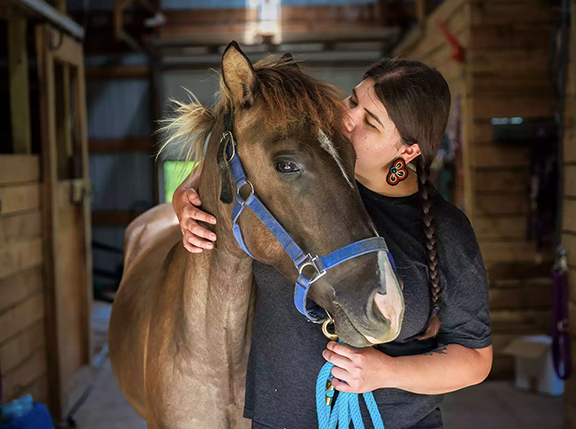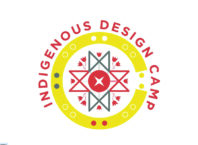
By Dan Kraker/MRP News
Em Loerzel grew up hearing stories about the Ojibwe horse from her uncle, about small ponies that would roam free near Ojibwe communities tucked among the forests and lakes along the Minnesota-Canada border, and help with tasks such as hauling wood and trap lines.
“I think when people think about Native people and their horses, they think of Lakota people or southwest people, but he would tell me, don’t forget that we are horse people too,” said Loerzel, a descendant of the White Earth Ojibwe Nation.
Loerzel has taken that teaching to heart. Earlier this year, the 28-year-old graduate student in social welfare at the University of Washington raised money to rescue six of the horses from a Canada rancher who could no longer afford to keep them.
She brought them to a farm owned by a friend outside River Falls, where Loerzel moved last year with her husband. And she started a nonprofit called The Humble Horse, to raise awareness about the breed–which is also known as the Lac La Croix pony, and to help revive it. Only about 180 Ojibwe horses remain, mostly in Canada.
The horses are small, sturdy and friendly. Last month, Loerzel nuzzled a 2-year-old stud colt named Mino. “Short for Mino Bimaadiziwin. That’s our word for ‘a good life.’ All of our Ojibwe horses have their Ojibwe names,” Loerzel explained.
“He’s just one of the sweetest guys. We Anishinaabe people bred them to be really smart, sweet, docile.”
They also adapted over the generations to survive in the border lakes country. Their small stature made it easier to navigate the forest.
Loerzel pointed out a unique inside flap in Mino’s nostrils that helps protect him from cold air. The horses also have small, fuzzy ears, to both protect from the cold and from black flies.
Late in July, one of the mares Loerzel rescued gave birth to a foal.
Loerzel says her main goal is to keep the horses safe and healthy. But she also wants to help Ojibwe people to reconnect with the horses.
“Because I’ve seen it where our own communities don’t know that we had these horses. It’s to make sure that Indigenous communities have connections to … our horse relatives.”
‘Heist across the Ice’
Thousands of Ojibwe horses once lived near Ojibwe communities on both sides of the border. They would roam free part of the year, but at other times were gathered to help with labor.
But their population dwindled in the first part of the 20th century. Many were killed and used to make dog food, even glue.
By 1977 there were only four left, on the Lac La Croix First Nation in Ontario, just north of the U.S.-Canada border.
Word spread that the Canadian government planned to exterminate them. So four men from the Bois Forte Reservation in Minnesota planned a rescue mission.
“They piled in a pickup truck, hooked up a horse trailer, drove across like beaver dams and portages and frozen ice in the middle of February, said Heather O’Connor, a Canadian author and journalist who spent five years researching Ojibwe horses.
It was dubbed the “Heist across the Ice.”
“I was thinking, well, I’m wondering if this is the last time I’m going to ever see those horses,” recalled Norman Jordan, a Lac La Croix council member who as a young boy remembers watching the men lead the horses away.
“Everybody was so attached to them, in a deep way, a spiritual way. And it was sad just seeing them being taken away.”
But those four rescued mares allowed the breed to survive. In Minnesota, they were bred with a Spanish mustang, and slowly, their numbers increased, largely among small herds in Canada.
Eight years ago, Darcy Whitecrow and Kim Campbell started Grey Raven Ranch on the Seine River First Nation, about 20 miles north of Voyageurs National Park in far northern Minnesota.
They use the horses as an educational tool. They run programs with aboriginal youth in Canada, and recently brought horses to the Grand Portage reservation powwow in northeastern Minnesota.
“Everybody was fascinated,” Whitecrow said. “It brought a sense of pride to the Ojibwe knowing that this was actually our ancestors’ horse.”
A dedicated network of people has developed to help preserve the breed, Campbell said. But often, a breeder will retire, or run out of money. She said more are needed for the breed to survive.
“The biggest thing is having people say, ‘Gee, I have a farm, I could have a breeding pair and do one baby a year.’ That’s our biggest need right now. And for the breed to survive, basically, people have to want it to survive.”
Dr. Gus Cothran, an emeritus professor at the veterinary college at Texas A&M University who has studied the genetics of the Ojibwe horse, said rare and endangered breeds like it often encounter the same challenge – they need more people willing to take care of them and breed them.
“And so one of the things that people involved with rare breeds need to do is create a market for them, and create a demand. And for a horse, that can be very difficult. They’re very expensive and demanding.”
Filling a void
In 2017, almost 40 years to the day after those four remaining horses were taken away from the Lac la Croix First Nation, the horses returned.
Norman Jordan, the boy who watched them leave, became Chief. And he helped bring a herd back to the community.
“It’s almost like when they left there was a piece of my history that was leaving, a piece of me, like a void that I’ve had for all these years. And then that night they came back, it’s like that piece that was missing was back now.”
Em Loerzel hopes to create a similar experience for Ojibwe people in Wisconsin and Minnesota to reconnect with their ancestral horse.
She also is doing her small part to ensure the breed’s survival. This summer she partnered with the University of Wisconsin River Falls to collect semen from their colt Mino, which can be used to breed Ojibwe Horse mares years into the future.
“We can maintain this biological material, literally, for decades in liquid nitrogen,” said Casie Bass, an Animal Science professor at UW-River Falls.
“This is a breed that’s indigenous to Minnesota and Wisconsin,” Bass said, “so we don’t want to lose this. Within the equine population, we want to maintain breeds.”
That’s why advocates for the breed are thrilled that Em Loerzel has started her small herd in Wisconsin.
But for Em Loerzel, it’s about more than maintaining a critically endangered breed. She said it’s important to her for Ojibwe people to have their horses back.
Because the Ojibwe Horse’s story, she said, parallels the story of Anishinaabe people.
“They were forcefully removed from their families. They were almost exterminated by the government. The population dwindled. And now we’re coming back. And now we’re thriving.”
Editor’s Note: Several photo captions in this story have been clarified to state that the Ojibwe horse is not native to the northern forests along the Canadian border, but rather has adapted to living in the region.
Minnesota Public Radio News can be heard on MPR’s statewide radio network or online.






